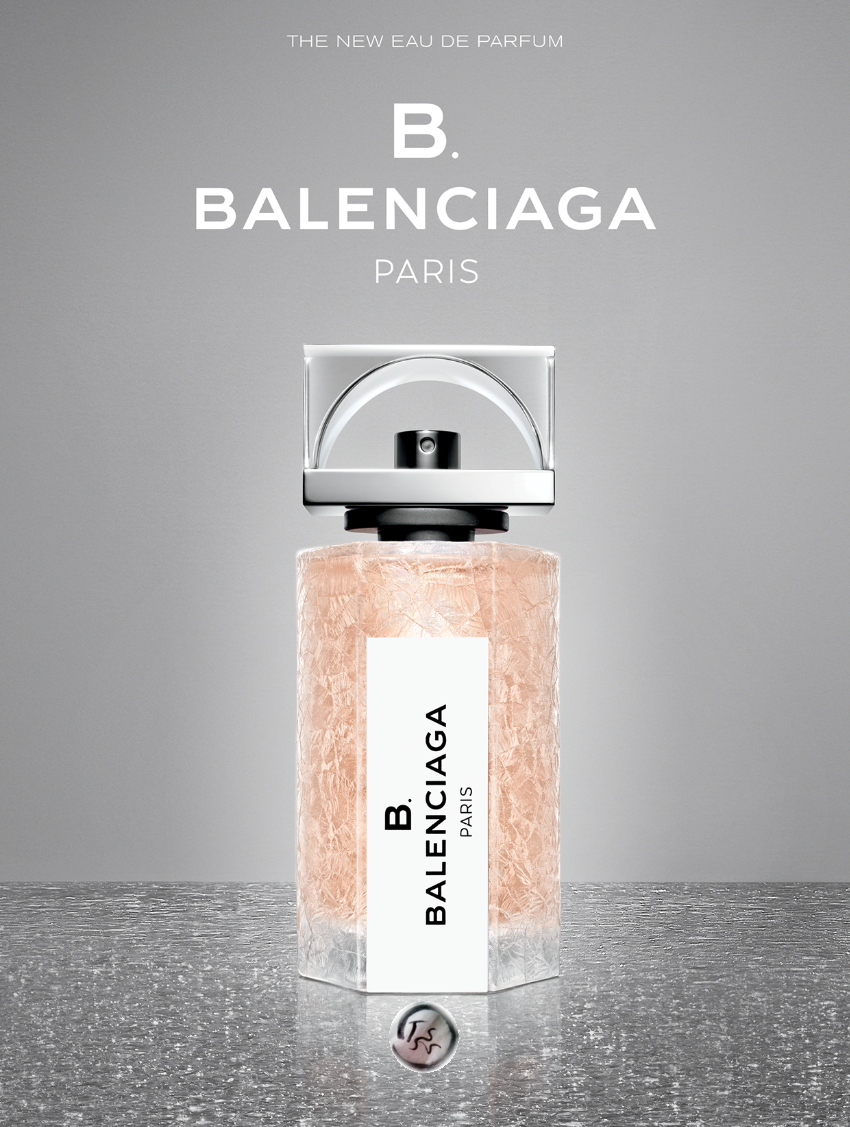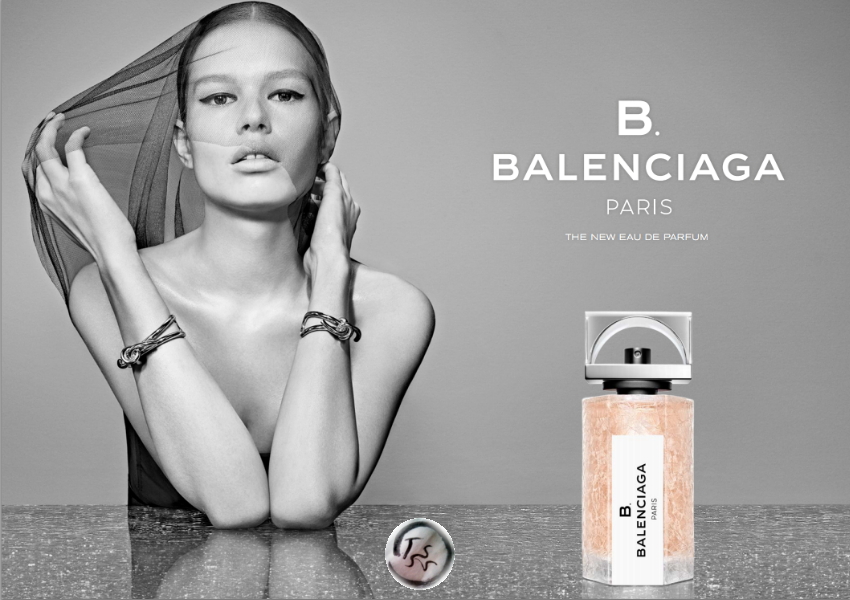Balenciaga B. (2014): Meaningful Olfactory Patchwork {Perfume Review & Musings}

B. Balenciaga is, you understand - or misunderstand perhaps - from the first moments, a rose perfume at the core but one which comes with twists. You are however not encouraged to think of the new scent in this way as no rose is mentioned at all by Balenciaga - or Alexander Wang, their new art director. It may be that the liquorishy and fruity, pear-like quality of ambrette seeds allied with iris manages to create the illusion of an invisible rose, or it may be that a rose is so necessary to round off anything in perfumery that you just add it without feeling the urge to spell it out. But there you go, it smells of a rose both familiar and twisted...
In the top, there is this Edamame twist which imparts a green, vegetaly nuance to the crystalline treatment of the rose. You maybe wouldn't recognize the vegetable as such if you didn't know it was present but you happen for once to remember this creative choice which bears the signature of Wang, who loves Japanese cuisine - the restaurant Daruma-Ya in New York City in particular. The Edamame note is instantly recognizable as you smell it bringing up a vision of frozen bags of little hairy and green vegetal croissants from Trader Joe's releasing their characteristic scent, after having been microwaved. This cool / warm contrast is in fact one which was sought out by the fragrance developers.
This novel nuance soon fades into another green range of scent, the anisic one - the latter also not mentioned. Wang did emphasize however that he has a taste for pungent green scents. Anis is a time-honored note in perfumery to add an asymetrical sensation which will smell a bit weird as in L'Heure Bleue, or more recently Dahlia Noir by Givenchy. All the while, the invisible rose retains its pink pigments and fruitiness. The rose accord is quite good at conveying the sensation of a plump, generously fruity rose dipped in pear liqueur. Lily of the valley is the flower of reference but it is not very prominent to my nose.
From the deeper notes of the fragrance arises a little bit of ambergris - Cashmeran wood is listed - for warmth and animality. Alexander Wang said in an interview with W Magazine that they added "masculine, woodsy notes."
It is this accentuated contrast between a crystalline, vegetaly green top bridged by rose and apposed to a fur-like base which determines the personality of B. most to me. Going back to Alexander Wang's comment, you could say that it also sums up the fashion designer's personality,
"I've always been attracted to scents with strong green notes, and we also added a darker woody flair to it,"
This creates this odd sensation of a fresh, brown mink fur coat just taken out of the fur fridge after the end of summer and scented with fistfulls of Anis de Flavigny candies left in the pockets, outside of their tin boxes. B. is quite vegetal and anisic, but also warm and animalic.
The composition intuitively conjures up a house precedent, the minty rose of Rosabotanica. Because the visual codes are so different for the two fragrances, it takes you a while to realize that the two perfumes are actually from the same house. Nicolas Ghesquières was more baroque visually. Alexander Wang privileges purity and minimalism.
As is de rigueur in perfumery creation for fashion houses, the current creators have integrated olfactory codes that have been popular previously for the house. Apart from the green and cool rose twist of Rosabotanica and B. Balenciaga, there is also the link to Balenciaga Paris with the clear violet facet of the fragrance which lingers on the skin long enough to remind you of that other predecessor - and its even more distant post-WWII violet-infused and precious powdery forebear, now sadly discontinued, Balenciaga Le Dix (1947).
 The very first association B. Balenciaga made me think of however lies outside the fashion house. There is a major referencing for me of Dahlia Noir by Givenchy signed by perfumer François Demachy, where the anis has been amplified while the ambergris makes a new appearance.
The very first association B. Balenciaga made me think of however lies outside the fashion house. There is a major referencing for me of Dahlia Noir by Givenchy signed by perfumer François Demachy, where the anis has been amplified while the ambergris makes a new appearance.
The overdosed anisic facet is like a new wave washing over the familiar formula to the point where the perfume permutates and becomes something else. It has reached that tipping point where olfactory quotes are discernable and a central inspiration can be found, but at the same time it has stylistically taken enough risk to create a qualitative jump.
B. Balenciaga is signed by perfumer Domitille Bertier of IFF who clearly managed to establish a good balance between faithfulness to the house codes, discreet innovation, and an homage paid to an admired predecessor from outside the house, again, I would stress, Dahlia Noir.
It may sound complicated and patchwork-like, and it is, except that as in this case, it works as a coherent whole. In the best tradition of the folksy creation of patchworks reflecting a story over several generations, B. Balenciaga integrates familiar motifs; a reference to an admired modern classic discovered on a trip ouside the confines of one's village, which struck the imagination; an object of exotic curiosity - edamame; and patient, collaborative sewing of the different parts which make up a meaningful and rich patchwork, one made up of history, and sometimes soul.
In this sense, B. Balenciaga despite all its sleek designing is in spirit an art-and-craft object born from a creative dynamic characteristic of popular culture.
It reminds you that even if the surface language of designer perfumery is elegance and personal talent, it is deep down a very popular object reflecting the sharing spirit, collaborative endeavors and inter-generational craftsmanship of the "sewers" who are all sitting around the same work table stitching up a new fragrance.
It is all really a question of balance. B. Balenciaga for me has managed to find a sense of equipoise and artful balance which makes it worthwhile to seek out rather than think of it as blatant plagiarism, as it happens. There is enough personal effort put into it that it balances out the visible borrowings. It is uncommon that a fragrance developer will divulge their fragrance template but it happens as in the case of Tory Burch Eau de Parfum.
In the end, the hedonistic factor remains as B. is an enjoyable fragrance to wear with an artful and well-balanced combination of qualities, if not endowed right out with unambiguous originality. It is not individual enough an effort for that to take place but it manages to convince you that, yes, they might be onto "a new olfactory direction" with this inspired green woody and rosy theme.









